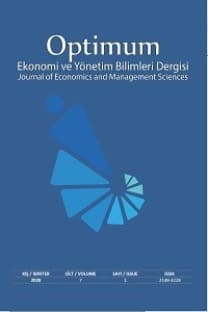Firma Değeri Yaratımında Marka Gücünün Etkisi: Interbrand İndirgenmiş Nakit Akışı Yöntemiyle Türk Markalarının Analizi
Araştırmanın amacı Türk markalarının değerlerinin hesaplanmasında marka gücünün ve bu markaların toplam satış hasılatları içerisinde markalı ürünlerinden elde ettikleri gelirlerin rolünün belirlenmesidir. Araştırma hem finansal hem de tüketici yönlü bakış açılarını olanaklı kılan karma hesaplama yöntemlerinden Interbrand marka değerleme yöntemiyle, Türk markalarının analizlerini kapsamaktadır. Araştırmanın uygulama kısmında, BrandFinance 2017 Türkiye’nin en değerli markaları sıralamasında yer alan; Türk Telekom, Turkcell, Türk Hava Yolları ve Arçelik incelenmiştir. Araştırma sonucunda değerlerine göre markalar sıralanmış ve bu sıralamaya göre Türk Telekom birinci, Turkcell ikinci, Arçelik üçüncü en değerli markalar olarak belirlenmiştir. Interbrand marka değerleme yöntemi ile en değerli Türk markalarının değerlendirilmesinin literatürde önemli bir boşluğu dolduracağı düşünülmektedir.
Anahtar Kelimeler:
Marka Değerleme, EVA, Marka Gücü, Talep Analizi, Firma Finansal Analiz
The Effect of Brand Equity on Firm Valuation: Analysis of Turkish Brands with Interbrand Discounted Cash Flow Method
The aim of the study is to determine the role of brand equity in the calculation of the values of Turkish brands and the role of these brands from their branded products in total sales revenue. The research covers the analysis of Turkish brands through Interbrand brand valuation method, which is one of the mixed calculation methods that enables both financial and consumer oriented perspectives. In the application part of the study, from the Brand Finance 2017 ranking list of Turkey’s most valuable brands; Turk Telekom, Turkcell, Turkish Airlines and Arcelik were examined. At the end of the research, the brands were listed according to their values and according to this ranking, Turk Telekom was determined as the first, Turkcell as the second and Arcelik as the third most valuable brands. The evaluation of the most valuable Turkish brands with Interbrand brand valuation method is considered to fill an important gap in the literature.
Keywords:
Brand Valuation, EVA, Brand Power, Firm Financial Analysis, Demand Analysis,
___
- Aaker, D. A. (1991). Managing Brand Equity: Capitalizing on the Value of a Brand Name, New York. Google Scholar.
- Barth, M. E., Clement, M. B., Foster, G., & Kasznik, R. (1998). Brand values and capital market valuation. Review of accounting studies, 3(1-2), 41-68.
- Berry, L. (2000). Cultivating Service Brand Equity. Journal of the Academy of Marketing Science, 28, 1, pp. 128-137.
- Blackston, M. (1992). Building Brand Equity by Managing the Brand’s Relationships. Journal of Advertising Research, 32, 3, pp. 79-83.
- Burmann, C., Jost-Benz, M. and Riley, N. (2009) Towards an Identity-Based Brand Equity Model. Journal of Business Research, 62, 390-397.
- Christodoulides, G., de Chernatony, L. (2010). Consumer-based brand equity conceptualisation and measurement: A literature review. International Journal of Market Research. 2010, Vol. 52 Issue 1, p43-66. 24p.
- De Chernatony, L., McDonald, M., & Wallace, E. (2011). Creating powerful brands. Butterworth-Heinemann,
- Hatipoğlu, Mercan (2011). Firma Değerlemesi Ve İmkb’de Enerji Sektöründe Uygulaması. Çankırı Karatekin Üniversitesi Sosyal Bilimler Enstitüsü İşletme Anabilim Dalı, Yüksek Lisans Tesi.
- Karataş, Özlem Nilüfer (2014). Marka Değerleme Modelleri: Bist – Bankacılık Sektöründe Bir Uygulama, T.C. Süleyman Demirel Üniversitesi Sosyal Bilimler Enstitüsü İşletme Anabilim Dalı, Doktora Tezi.
- KAYA, Yusuf (2002). Marka Değerleme Metotları Ve Bu Metotların Kullanımında Sermaye Piyasası Mevzuatı Açısından Çıkabilecek Sorunlarsermaye Piyasası Kurulu Denetleme Dairesi Yeterlik Etüdü, İstanbul.
- Keller, K. L. (1993). Conceptualizing, measuring, and managing customer-based brand equity. the Journal of Marketing, 1-22.
- Keller, K. L. (1993). Conceptualizing, measuring, and managing customer-based brand equity. the Journal of Marketing, 1-22.
- Leslie De Chernatony, Malcolm McDonald, Elaine Wallace (2011). Creating Powerful Brands, ISBN 1856178498, 9781856178495, Routledge.
- Wasserman, B. (2015). Valuation of Intangible Assets: Should Brand Equity Be Accounted for on the Balance Sheet?.
- Zambon, S., & Monciardini, D. (2015). Intellectual capital and innovation. A guideline for future research. Journal of Innovation Economics & Management, (2), 13-26.
- Yayın Aralığı: Yılda 2 Sayı
- Başlangıç: 2014
- Yayıncı: -
Sayıdaki Diğer Makaleler
İlk Doğum Kararının Sosyoekonomik Belirleyicileri: Eş Zamanlı Hazard Modelleri
Marka Aşkının Öncülleri ve Sonuçları: Doğu Karadeniz Bölgesinde Bir Uygulama
Örgütler Arası İlişki Bağlamında Açık İnovasyonu Anlamak: Kavramsal Bir Değerlendirme
Ayşegül ÖZBEBEK TUNÇ, Oya ZİNCİR
Türkiye’de Ekonomik Büyüme ve Enflasyon İlişkisi
Mehmet Aldonat BEYZATLAR, İstemi BERK
Rekabetçi Devlet Modelinin Maliye Politikasına İlişkin Teorik Değerlendirmesi
Mustafa Alpin GÜLŞEN, Ali Gökhan GÖLÇEK
Bulanık ve Gri COPRAS Yöntemleri Kullanılarak Tedarikçi Seçim Modeli Geliştirilmesi
Bahadır Fatih YILDIRIM, Mehpare TİMOR
Hollanda Adalet Sisteminde Performans Esaslı Bütçeleme Uygulaması
